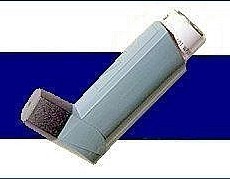
You’ve probably seen one of these on your own pool deck
Asthma is a chronic inflammatory disease characterised by hypersensitivity of the airways, causing airways to become obstructed. Exercise induced bronchospasm, or asthma, is a condition defined as a temporary narrowing of the airways induced by strenuous exercise7. Whether the prevalence of asthma is higher in athletes than the general population remains controversial4.
People with asthma begin with hypersensitive airways. When exposed to certain stimuli, these airways react by contracting7. Cold weather events, such as skiing, ice hockey, basketball, field hockey or football are more likely to aggravate airways than sports such as swimming. Breathing cold, dry air makes asthma symptoms worse for many people2.
Asthmatics contain mast cells within their lungs. Chemicals know as mediators secreted from these cells stimulate mucus gland secretion into the airways. Such mucus production is associated with asthma attacks. In particualr the secretion of mucus is greater when the airways become cool and dry. This blocks the airways, causing the surrounding muscles to spasm thereby contracting and tightening the airway1. Breathing warm, humidified air can completely or partially prevent exercise induced asthma as this counteracts the cooling and drying of the airways. These are the exact conditions experienced during swimming.
Many elite athletes have asthma. Indeed, at the 1984 Olympics, 41 of 67 athletes with proven exercise induced asthma won medals in various sports11. Since asthma medications were made legal to ingest by inhaler, no swimmer has tested positive and the quantities of asthma medication found via doping in urine are well below thresholds for positive tests. According to IOC officials, however, around 60% of athletes use asthma medications but only a small proportion of these individuals are actually asthmatics9.
After a series of bronchitis incidences a few years ago, I myself was diagnosed as an asthmatic. For about two years I took medication, which I felt had little effect on my ‘asthma symptoms’. Diagnosis and medical intervention for exercise-induced bronchospasm are often based on self-reported symptoms, without spirometric confirmation8. Many sports governing bodies now demand that athletes undergo tests for asthma by registered respiratory physicians due to the findings that many athletes are given inhalers without being asthmatics.
I was ordered to undergo such tests by the ASFGB in order to ‘prove’ I was asthmatic and therefore that I required medication. The tests came back and showed that my lung function was completely normal and that I did not have asthma. Hence I was told by the swimming governing body that I was to stop using the inhalers or undergo further tests if I believed I needed the medication. Having stopped the medication, I have never had any adverse effects or breathing difficulties. I would therefore recommend questioning physicians when told you are asthmatic if you fail to believe you truly suffer from asthma. Symptoms of shortness of breath during exercise, a cough, lack of energy and loss of form are all symptoms of many other potential illnesses. The sudden growth of asthma inhalers on our own pool deck is worrying in this respect.
Numerous healthy athletes believe that inhaling asthma medication enhances performance, as they dilate the airways thereby enhancing breathing and enabling more oxygen to be transported to muscles. However, most research shows that legal asthma medications are not performance enhancing. A placebo effect may exist to give the impression of enhanced performance i.e. the psychological belief in improved performance via inhaler use causes improved performance alone4.
Corticosteroid inhalers are the most effective, common preventer given to asthmatics as they work to reduce and prevent airway inflammation, swelling and mucus. Whilst they must be used regularly, they do not have immediate impact7. This means they have no value when an effect is needed in minutes. It is frequently observed that athletes use their inhalers and appear to notice an immediate effect, providing support for the placebo effects!
Despite the fact that research consistently shows swimming is especially suited for people with asthma, recent studies have indicated that people who swim competitively and train more than 30 hours a week, have an increased incidence of asthma10, however a study of 1282 Finnish competitive athletes found no evidence that vigorous exercise significantly influences asthma prevalence5.
This suggests that a potentially detrimental factor for athletes training in such quantities is the chlorine used in pool water. Specifically it is the chlorine derivative nitrogen tri-chloride that causes airway irritation. When chlorine gas mixes with ammonia and urea (from sweat or urine in pools), this substance is created10.
Urea and ammonia can be removed by circulating ozone in pools. However, re-circulation of air causes increased concentrations of nitrogen tri-chloride to levels that may irritate the airways10. There is also evidence to suggest that chloroform air levels in swimming pools may represent a carcinogenic risk to highly exposed populations such as competitive swimmers6.
Despite the recent scare that swimming ‘causes’ asthma, the amount of research showing swimming enhances/prevents asthma symptoms far outweighs research showing it causes the condition. As few club swimmers train over 30 hours weekly, there is little cause for concern that swim training increases the risks of developing asthma.

